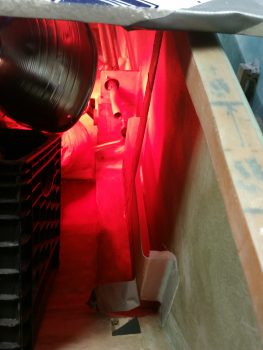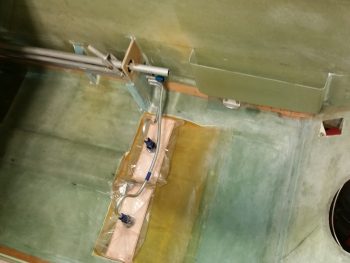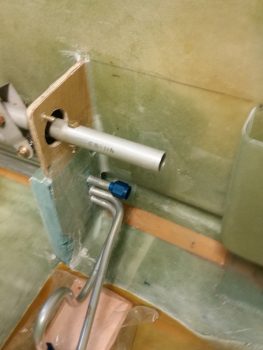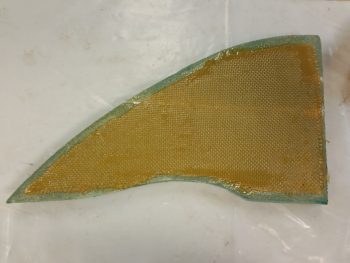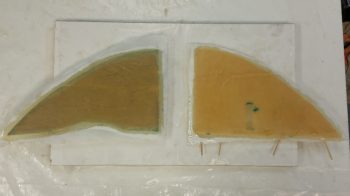This morning when I happily went down to check out my layup, I didn’t stay happy very long. As I was ripping off the peel ply, which is admittedly one of the best ways to start out a morning, a couple of areas still seemed a bit soft and not fully cured. This was not really what I was expecting since I had used fast hardener. Ironically, I had just had a discussion within the preceding days on fast hardener, as I extolled its virtues.
There is of course a possibility that I jacked up the ratio, but I am usually pretty good at ensuring those are correct. Regardless, I decided to cook it for a while and set my sights in at a good post cure temp: 140° F for 4 hours. Over the next couple of hours I checked various spots and never had the IR thermometer go past the mid 150° area, and only in a couple spots. And I was checking just about every area in each heat lamp’s path (more on this below).
Besides the heat lamps, in this pic below you can see that I glassed the aft side of the GIB armrest storage pocket with 2 plies of BID.
Here it is a bit later after it cured. Note the yellow spot at the front side.
 And below you can see the yellow spot again. After establishing that my average temps on all the stuff I checked being in the heat area, including the sidewall and the storage pocket, were in the high 120s to high 130s, I ran out to grab a bite to eat and go to the store. When I checked the heat lamps a bit later I saw this discoloration. I immediately checked the temp as I was pulling the lamp away, and it was 162.9°. I also did a quarter test and could find no delamination. Since a good portion of the yellow will get cut out when I open up the sidewalls for the baggage area, I’ll check the foam & glass again then. But for right now, nothing seems odd except the color change. Moreover, MGS 285 epoxy should have a multi-hour post cure over 170°. I guess just that high of heat concentrated on that one spot over time caused the discoloration.
And below you can see the yellow spot again. After establishing that my average temps on all the stuff I checked being in the heat area, including the sidewall and the storage pocket, were in the high 120s to high 130s, I ran out to grab a bite to eat and go to the store. When I checked the heat lamps a bit later I saw this discoloration. I immediately checked the temp as I was pulling the lamp away, and it was 162.9°. I also did a quarter test and could find no delamination. Since a good portion of the yellow will get cut out when I open up the sidewalls for the baggage area, I’ll check the foam & glass again then. But for right now, nothing seems odd except the color change. Moreover, MGS 285 epoxy should have a multi-hour post cure over 170°. I guess just that high of heat concentrated on that one spot over time caused the discoloration.
Moving on. Note that the right front sump wall extension piece layup is complete! The heat lamps did there job and the spots I was concerned about cured nicely . . . except one.
The area on the aft side of the foam at the bottom didn’t seem to be fully cured. If this were slow hardener I wouldn’t have worried about it, but since the other areas were cured, this concerned me. Now, it still looked like a solid layup, but the overhanging glass was just a bit too pliable for my liking. I decided that in the 1 inch area that I would be laying up the BID tape for the outside of the right sump wall, that I would remove this glass. Since I had laid up 2 plies over just the one on the sump wall extension, I broke through to foam in a couple spots. No worries. I’d rather have fresh foam for the next layup then putting good glass over some that is a bit suspect. As for the rest of that layup, it’s in there and sticking, but I have so much other glass around it, I’m not concerned if its strength is a little less than normal.
In the right pic you can see the front side of the layup.
I wanted to show the access holes on the outboard side of this layup: the top hole is for the bundle of small wires that will traverse this bulkhead heading back to the aft areas of the plane. The bottom hole is for the 2 big power wires to go through.
You can see that I also made the big power wire channel on the foam fuel line bracket as well.
So here’s a shot of all the layups I did last night, after I cleaned it all up. One good thing that happened is that weighing down the fuel lines worked. The fuel lines are in the correct position and have no tendency to try to rotate upwards.
 I then finalized my dimensions and shape for the fuel sump profile. I took some scrap 3/4″ thick Divinycell foam and cut the pieces for the left & right sump walls. I then micro’d the pieces together.
I then finalized my dimensions and shape for the fuel sump profile. I took some scrap 3/4″ thick Divinycell foam and cut the pieces for the left & right sump walls. I then micro’d the pieces together.
I then cut out the middle sump rib from 3/8″ Divinycell foam. I loaded everything in the backseat for a quick mockup to see how it all looked & fit.
 I then spent a good 25 minutes shaping the left fuel sump wall.
I then spent a good 25 minutes shaping the left fuel sump wall.
I figured out the fit on the middle fuel sump rib as well. If you’re wondering why the bottom of the middle rib is cut, there is a technical term for that: it’s called being unfocused, not concentrating on the task at hand and having a major brain fart! I noted on the left side wall that the base of it matches the base of the front wall. I then inexplicably picked up the middle rib and had it cut and was putting it back in to check before I even realized the mistake I had made! Luckily, this is foam and composites, and it’s all easily fixed!
I started with the interior left wall and laid up the first ply, which is Kevlar.
I then laid up 1 ply of BID on the interior left wall (ply #2), and then –after reattaching the bottom strip– I laid up 1 ply of BID on the left side of the middle fuel sump rib.
I then trimmed the overhanging glass down.
And peel plied the layups.
Previously, I had laid up the forward side of the GIB armrest storage pocket with 2 plies of BID and a 1″ strip of BID down the front face of the foam fuel line bracket. I then checked those to ensure that they were good to go.
Finally, since my garage is in the low 70’s I decided to put the freshly glassed sump wall pieces under heat.
Then I realized it was a bit too much heat and turned off one of the lamps and moved the sump wall pieces a bit farther away.
Tomorrow I’ll continue to work on the thigh support fuel sump and try to get this thing knocked out . . . hopefully a bit more error free!

